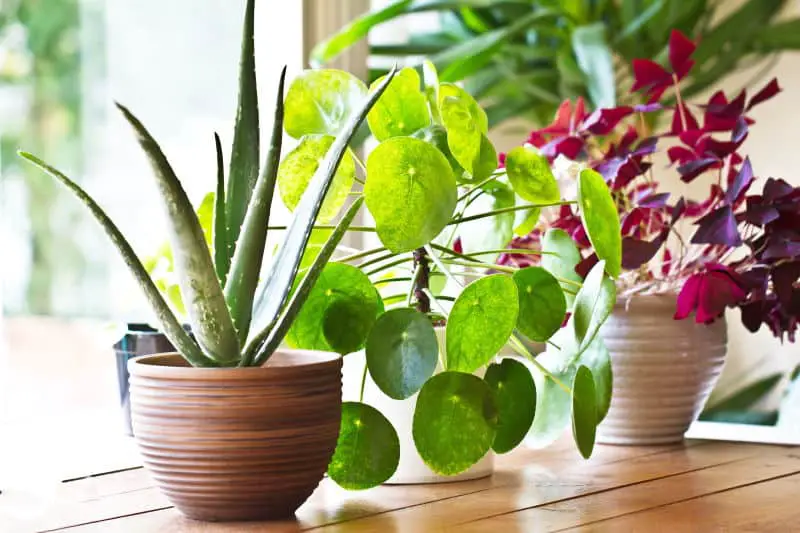Electromagnetic field (EMF) radiation has been a major concern over recent years. Almost every day you’re exposed to radiation coming from sources such as your cell phone, cell towers, computers, TVs, Wi-Fi routers and home appliances. Therefore, using materials that can block, shield or absorb EMF can be great for your health.
There are a lot of EMF filters that help reduce exposure to EMF radiation in your home and office. Many people are now turning to the use of indoor plants as a means of reducing exposure to EMF radiation.
For a long time, indoor plants have been used in homes and offices to provide a stylish and natural décor. Nowadays, they are also used as a way to purify the air inside a room and absorb toxins including electromagnetic radiation.
Plants are very useful in that they provide various health benefits. You will always feel good when surrounded by plants because they help detoxify the air around you and they boost your immune system.
There are a variety of plants you can grow indoors, including edible herbs. The herbs have various health benefits and they are also good for seasoning a meal.
Planting a variety of plants indoors is associated with improved mood and increased quality of life. These plants give off a lot of beautiful scents that make your home feel fresh and welcoming. For example, having a fragrant herb like thyme placed on a desk or table at the corner of the living room will boost the energy levels in the room.
Some people want to use plants to protect themselves from EMF radiation.
Do Indoor Plants Absorb Radiation?
Yes, indoor plants, though not all of them, can actively absorb certain electromagnetic frequencies and other types of radiation in our homes. Some are better at absorbing EMF radiation than others.
These plants not only absorb radiation, but they also give off a lot of oxygen which makes the air in your home cleaner, feel brighter and smell fresh.

According to research done by NASA, indoor plants do absorb radiation. Therefore, placing some of these plants in your home or office not only purifies the air of toxins inside the room, it can also help reduce radiation exposure. Planting at least 2 of these plants in every 100 square feet of space will remove all the toxins in the room.
The plants are great for neutralizing the air around your home. As a result, they improve the air quality. The plants breathe in carbon dioxide from the air and in return, they emit oxygen into the air.
Keeping these plants indoors can help you feel energized, reduce your stress levels and reduce headaches associated with exposure to a lot of radiation.
How Indoor Plants Absorb Radiation
Indoor plants mitigate the harmful effects of electromagnetic field radiation. They absorb the radiation generated by the technology around you and create a safer and healthier environment.
Plants situated in close proximity to electronic devices that emit EMF radiation do absorb the radiation emitted by these devices. You can get a plant and place it next to your work space, or wherever you have your computer or laptop.
The plants not only contribute to the beauty of the area and make you feel calm, they absorb electromagnetic radiation from the laptop and other EMF sources in your workspace.
Exposure to EMF radiation can be very dangerous for your health, therefore, it’s a good practice to have EMF protection plants in your home.
These plants are very easy to plant and take care of. Since the amount of radiation they absorb is relative to their size, choose the largest plant that is appropriate for your space. Even small plants have a beneficial effect, and can be placed on the tables and shelves around the room.
Watch this video to learn more about how indoor plants absorb radiation:
Indoor Plants That Absorb EMF Radiation
1. Areca Palm
This is a great indoor plant that absorbs the toxins in your room. This member of the palm family transpires very effectively, which makes the plant great for removing toxins in the air.
The rate at which toxins are absorbed from the room depends on the rate of transpiration. The more it transpires, the faster it absorbs the air down to the plant roots and the faster the toxins are removed from the room. This houseplant does well in dry areas.
2. Cacti/Succulent Plants
The many types of succulent plants are actually varieties of cactus. They have fresh looking stems and leaves that are full and distinctly spiky looking. They are sometimes “prickly” to the touch. Succulents are one of the best plants to use for EMF protection.
According to NASA research, this type of plant can absorb the electromagnetic radiation emitted by various devices in your home or office.
The plant absorbs radio frequency (RF) radiation from cell phones, Wi-Fi-routers and microwave radiation. Growing succulent cacti in pots in your house or office purifies the air inside the rooms they are placed in.
Since radiation is invisible and travels in a straight line, placing the cactus between you and the EMF emitting source is an effective way of reducing exposure to electromagnetic radiation. For example, you can place the cactus on a table with a computer to absorb the radiation emitted by the computer and any other electronic device near you.
You can easily grow a cactus plant by either cutting off and planting some leaves from a mother plant or by growing it from seed. If you choose to propagate the cactus or succulent plant from another plant, make sure to cut a piece from a larger healthy cactus mother plant. Then plant it in a pot with cactus friendly soil. This type of soil typically has more sand in it, since this plant needs good drainage.
The pieces should be planted at least 2 inches deep, then the soil should be watered. They are easy to maintain; you’re only required to water a cactus once or twice a month. Do not overwater a cactus! They do not generally require any fertilization.
You can use decorative pots to grow these types of plants, and due to their small size they can be a perfect centerpiece for any table or desk. You can also give these plants to your loved ones as a perfect gift for any occasion.
3. Snake Plant Sansevieria
Snake plants have stiff sword-like leaves. This classic house plant is available with leaves that have grey, silver or gold edges. They can make your home more welcoming and natural.
The contemporary sansevieria houseplant is highly adaptable to any environment. It can easily tolerate low, medium or bright light in your room, but it will do especially well near a window with a lot of sunlight. It should be grown in a premium soil and fertilized occasionally.
The snake plant is common in West Africa but it is easily available wherever ornamental plants are sold. Growing this type of plant indoors neutralizes the negative effects of EMF radiation.
It acts as an air purifier that removes volatile organic compounds (VOCs) from your home and office. Furthermore, it acts as an antidote to exposure to different types of radiation. For example, it protects you from exposure to RF signals, microwave radiation and extremely-low frequency (ELF) electromagnetic field radiation.
This type of plant absorbs over 100 types of toxic materials from the surrounding environment, leaving you with only fresh air to breathe.
When you grow a snake plant in your home or office, remember these basic facts and recommendations:
- The plant does well in a fast draining soil.
- These plants do well in temperatures normally favorable to humans. They can grow well in temperatures between 50 to 80 degrees Fahrenheit.
- The plant will grow well in an environment with good lighting, and although it will do best in bright light, they can also survive in dark areas.
- The plants don’t require a lot of water since the plant naturally grows in mostly dry conditions.
4. Spider Plant/Chlorophytum Comosum
The spider plant acts as a natural air purifier that absorbs various toxins and pollutants from the air. It can absorb harmful gases inside your house such as formic acid, aldehyde and carbon dioxide. As the plants absorb carbon dioxide, they in turn emit oxygen which humans need to breathe.
The spider plant is very effective at absorbing radiation as well. The ability of the plant to absorb major pollutants makes them effective in shielding you from various EMF sources.
This type of plant can survive even in the harshest conditions, but will thrive and grow quickly if treated well. If the conditions are favorable for plant growth, then the spider plant will have stunning leaves that complement your home or office décor as well as providing protection from EMF sources around you.
Spider plants are very easy to grow. All you need to do is to get a plant that already has formed roots and plant it in a pot. You should only water the plant when the soil is dry, and water the soil to an evenly moist condition. Do not overwater the plant.
5. Betel Leaf Plant
Betel leaf plants can grow up to 10 to 15 ft high with a lot of branching vines. The plant does well in warm humid climates. It is commonly grown in parts of South Asia and its extracts protect you from non-ionizing radiation.
Betel leaf plants are great for protecting against EMF radiation. According to research by the Department of Biochemistry in the Graduate Institute of Medical Sciences located in Kolkata, betel plants do reduce radiation.
The extract of the betel plant was used to show that the plant reduces radiation by inducing the DNA strands to reduce the breaking of their concentration in your body. Therefore, this plant is great to protect your DNA from the harmful effects of radiation.
6. Stone Lotus Flower
Stone lotus flower acts as an air purifier and its small size makes it perfect for placing at your table or desk. A lot of people prefer this type of plant for growing indoors because of its beauty and small size. The stone lotus flower can also be used in the production of essential oil.
This type of flower can absorb toxins such as EMF radiation emitted in your house from technology such as computers, cell phones, Wi-Fi routers and other wireless devices around your home and office. Therefore, putting a pot with stone lotus flowers on top of your desk will absorb radiation emitted by these devices.
7. Aloe Vera
Aloe vera is another powerful house plant that has multiple health benefits. It is mostly used for its medicinal properties. The plant contains various minerals, amino acids, proteins and other types of nutrients.
It is very easy to grow aloe vera at home, and it can do well in almost any type of environment. They need very little care; you only need to water them every two to four weeks. In addition, fertilize the plant occasionally if you want it to grow and thrive.
Aloe vera plants do well in areas with bright, but not direct sunlight. You should put the pot near a window facing either south or west for them to grow the best.
They grow well in cactus soil that drains fast. Alternatively, you can mix your potting soil with either sand, perlite or pumice.
This plant is believed to absorb EMF radiation in your house. Placing pots of aloe vera on your desk or throughout your house can neutralize all radiation emitted by various electronic devices as well as purify the air around you.
8. Rubber Plant
Rubber plants are among the oldest and most popular houseplants in the world. A rubber plant is easy to grow and take care of. They can be purchased quite small, and their fast growth rate makes them ideal for the plant enthusiast! Placing one at your desk either in the office or at your home has great benefits. You can propagate this type of plant by either using stem cuttings or by planting seeds in a small tray.
The rubber plant requires bright light in order to grow well. You can also use artificial light on the plant. It requires little maintenance and sometimes because of its rapid growth, you have to trim the plant to keep it the optimum size for your space.
This plant has properties that help absorb all electromagnetic waves in your home. The plant is able to remove all toxins in the surrounding environment including radiation. Therefore, placing the plant near electronic devices will absorb radiation emitted by those devices.
You can put several pots in all the corners of your house to purify the air inside your home and give your home a tropical feel.
Summary
In today’s world, you’re exposed to a lot of harmful electromagnetic smog. Exposure to too much electromagnetic smog may result in various health issues. For example, exposure to radio frequency (RF) radiation from your cell phone and other wireless devices can increase the risk of cancer or damage to your DNA cells.
Growing indoor plants, like the spider plant or aloe vera or others mentioned above, can help you reduce the risk of exposure to EMFs. Although many people grow plants in their homes to protect against EMF radiation, the plants also have other health benefits like boosting your immune system. They add some natural elements to your home and can be used as a way to complement your home décor.
Protecting yourself and your loved ones from the dangers of electromagnetic radiation is very important. One of the easiest ways of reducing your exposure is eliminating some of the EMF sources around you.
Since it is not always easy to be without electronic devices like cell phones, growing EMF protection houseplants will help you reduce the negative effects of exposure to these sources of electromagnetic radiation.
Having one of these houseplants in your sitting area, bedroom or office will enhance any home décor and make your room look and feel more healthy and fresh. Furthermore, some of these indoor plants have a nice fragrance that leaves your home smelling clean.
In addition to absorbing and protecting you from harmful EMF radiation, these great plants also act as general air purifiers. They remove all toxins and dangerous gases from your house, and give off oxygen which is essential for humans.


